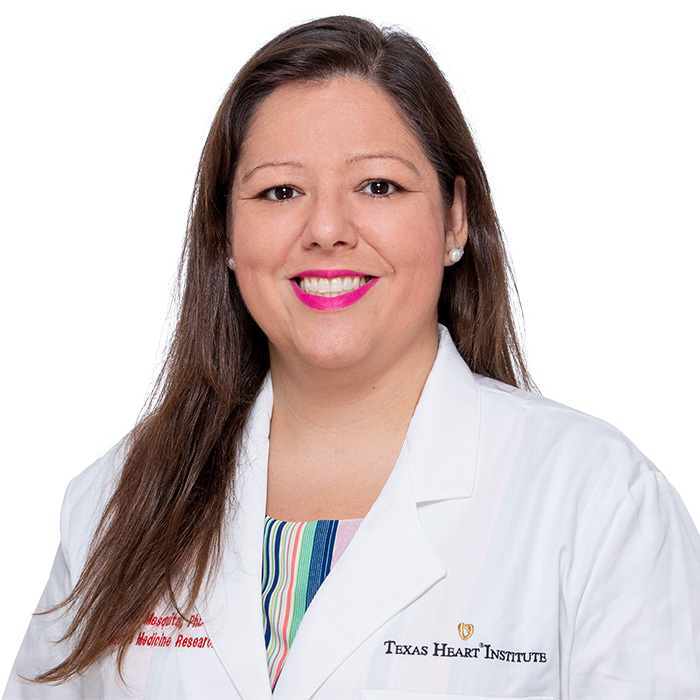
Fernanda Paccola Mesquita, PhD
Texas Heart Institute Positions
- Research Scientist, Regenerative Medicine Research
Publications
4862227
PXVTG4ES
1
alternatives-to-animal-experimentation
10
date
desc
Mesquita
2002
https://www.texasheart.org/wp-content/plugins/zotpress/
%7B%22status%22%3A%22success%22%2C%22updateneeded%22%3Afalse%2C%22instance%22%3Afalse%2C%22meta%22%3A%7B%22request_last%22%3A0%2C%22request_next%22%3A0%2C%22used_cache%22%3Atrue%7D%2C%22data%22%3A%5B%7B%22key%22%3A%2269GRKEEX%22%2C%22library%22%3A%7B%22id%22%3A4862227%7D%2C%22meta%22%3A%7B%22creatorSummary%22%3A%22Mesquita%20et%20al.%22%2C%22parsedDate%22%3A%222022-12-07%22%2C%22numChildren%22%3A2%7D%2C%22bib%22%3A%22%3Cdiv%20class%3D%5C%22csl-bib-body%5C%22%20style%3D%5C%22line-height%3A%201.35%3B%20padding-left%3A%201em%3B%20text-indent%3A-1em%3B%5C%22%3E%5Cn%20%20%3Cdiv%20class%3D%5C%22csl-entry%5C%22%3E%3Cstrong%3EMesquita%3C%5C%2Fstrong%3E%2C%20F.%20C.%20P.%2C%20Leite%2C%20E.%20S.%2C%20Morrissey%2C%20J.%20et%20al.%20%282022%29.%20Polymerized%20laminin-521%3A%20a%20feasible%20substrate%20for%20expanding%20induced%20pluripotent%20stem%20cells%20at%20a%20low%20protein%20concentration.%20%3Ci%3ECells%3C%5C%2Fi%3E%20%3Ci%3E11%3C%5C%2Fi%3E%2C%203955.%20%3Ca%20class%3D%27zp-DOIURL%27%20href%3D%27https%3A%5C%2F%5C%2Fdoi.org%5C%2F10.3390%5C%2Fcells11243955%27%3Ehttps%3A%5C%2F%5C%2Fdoi.org%5C%2F10.3390%5C%2Fcells11243955%3C%5C%2Fa%3E.%3C%5C%2Fdiv%3E%5Cn%3C%5C%2Fdiv%3E%22%2C%22data%22%3A%7B%22itemType%22%3A%22journalArticle%22%2C%22title%22%3A%22Polymerized%20laminin-521%3A%20a%20feasible%20substrate%20for%20expanding%20induced%20pluripotent%20stem%20cells%20at%20a%20low%20protein%20concentration%22%2C%22creators%22%3A%5B%7B%22creatorType%22%3A%22author%22%2C%22firstName%22%3A%22Fernanda%20C.%20P.%22%2C%22lastName%22%3A%22Mesquita%22%7D%2C%7B%22creatorType%22%3A%22author%22%2C%22firstName%22%3A%22Eliel%20S.%22%2C%22lastName%22%3A%22Leite%22%7D%2C%7B%22creatorType%22%3A%22author%22%2C%22firstName%22%3A%22Jacquelynn%22%2C%22lastName%22%3A%22Morrissey%22%7D%2C%7B%22creatorType%22%3A%22author%22%2C%22firstName%22%3A%22Catarina%22%2C%22lastName%22%3A%22Freitas%22%7D%2C%7B%22creatorType%22%3A%22author%22%2C%22firstName%22%3A%22Tatiana%22%2C%22lastName%22%3A%22Coelho-Sampaio%22%7D%2C%7B%22creatorType%22%3A%22author%22%2C%22firstName%22%3A%22Camila%22%2C%22lastName%22%3A%22Hochman-Mendez%22%7D%5D%2C%22abstractNote%22%3A%22Laminins%20%28LNs%29%20play%20a%20central%20role%20in%20the%20self-assembly%20and%20maintenance%20of%20basement%20membranes%20and%20are%20involved%20in%20critical%20interactions%20between%20cells%20and%20other%20extracellular%20matrix%20%28ECM%29%20proteins.%20Among%20the%20defined%2C%20xeno-free%20ECM%20culture%20matrices%2C%20LNs-namely%20LN521-have%20emerged%20as%20promising%20coating%20systems%20for%20the%20large-scale%20expansion%20of%20induced%20pluripotent%20stem%20cells%20%28iPSCs%29.%20The%20biologic%20activity%20of%20LNs%20is%20enhanced%20by%20their%20acidification-induced%20self-polymerization%20into%20a%20cell-associated%20network%20called%20polylaminin%20%28polyLN%29%2C%20which%20can%20recapitulate%20the%20native-like%20polymeric%20array%20in%20a%20cell-free%20system.%20Here%2C%20we%20show%20for%20the%20first%20time%20to%20our%20knowledge%20that%20polyLN521%20displays%20a%20native-like%20hexagonal-like%20structure%20and%20that%2C%20at%20basal%20and%20low%20concentrations%2C%20it%20permits%20the%20large-scale%20expansion%20of%20human%20iPSCs.%20Human%20iPSCs%20expanded%20with%20polyLN521%20maintained%20the%20pluripotent%20state%20and%20showed%20no%20impairment%20of%20karyotype%20stability%20or%20telomere%20length.%20These%20results%20suggest%20that%20low-concentration%20polyLN521%20is%20a%20stable%20and%20cost-effective%20coating%20for%20large-scale%20iPSC%20expansion.%22%2C%22date%22%3A%22Dec%2007%2C%202022%22%2C%22language%22%3A%22eng%22%2C%22DOI%22%3A%2210.3390%5C%2Fcells11243955%22%2C%22ISSN%22%3A%222073-4409%22%2C%22url%22%3A%22%22%2C%22collections%22%3A%5B%22MJL5PY3A%22%2C%22PXVTG4ES%22%2C%22N9FF4AWY%22%2C%22TXW6RMW4%22%5D%2C%22dateModified%22%3A%222023-01-06T17%3A14%3A44Z%22%7D%7D%2C%7B%22key%22%3A%22FHWXI2QZ%22%2C%22library%22%3A%7B%22id%22%3A4862227%7D%2C%22meta%22%3A%7B%22creatorSummary%22%3A%22Morrissey%20et%20al.%22%2C%22parsedDate%22%3A%222022-06-30%22%2C%22numChildren%22%3A2%7D%2C%22bib%22%3A%22%3Cdiv%20class%3D%5C%22csl-bib-body%5C%22%20style%3D%5C%22line-height%3A%201.35%3B%20padding-left%3A%201em%3B%20text-indent%3A-1em%3B%5C%22%3E%5Cn%20%20%3Cdiv%20class%3D%5C%22csl-entry%5C%22%3EMorrissey%2C%20J.%2C%20%3Cstrong%3EMesquita%3C%5C%2Fstrong%3E%2C%20F.%20C.%20P.%2C%20Chacon-Alberty%2C%20L.%20et%20al.%20%282022%29.%20Mining%20the%20mesenchymal%20stromal%20cell%20secretome%20in%20patients%20with%20chronic%20left%20ventricular%20dysfunction.%20%3Ci%3ECells%3C%5C%2Fi%3E%20%3Ci%3E11%3C%5C%2Fi%3E%2C%202092.%20%3Ca%20class%3D%27zp-DOIURL%27%20href%3D%27https%3A%5C%2F%5C%2Fdoi.org%5C%2F10.3390%5C%2Fcells11132092%27%3Ehttps%3A%5C%2F%5C%2Fdoi.org%5C%2F10.3390%5C%2Fcells11132092%3C%5C%2Fa%3E.%3C%5C%2Fdiv%3E%5Cn%3C%5C%2Fdiv%3E%22%2C%22data%22%3A%7B%22itemType%22%3A%22journalArticle%22%2C%22title%22%3A%22Mining%20the%20mesenchymal%20stromal%20cell%20secretome%20in%20patients%20with%20chronic%20left%20ventricular%20dysfunction%22%2C%22creators%22%3A%5B%7B%22creatorType%22%3A%22author%22%2C%22firstName%22%3A%22Jacquelynn%22%2C%22lastName%22%3A%22Morrissey%22%7D%2C%7B%22creatorType%22%3A%22author%22%2C%22firstName%22%3A%22Fernanda%20C.%20P.%22%2C%22lastName%22%3A%22Mesquita%22%7D%2C%7B%22creatorType%22%3A%22author%22%2C%22firstName%22%3A%22Lourdes%22%2C%22lastName%22%3A%22Chacon-Alberty%22%7D%2C%7B%22creatorType%22%3A%22author%22%2C%22firstName%22%3A%22Camila%22%2C%22lastName%22%3A%22Hochman-Mendez%22%7D%5D%2C%22abstractNote%22%3A%22Close%20examination%20of%20the%20initial%20results%20of%20cardiovascular%20cell%20therapy%20clinical%20trials%20indicates%20the%20importance%20of%20patient-specific%20differences%20on%20outcomes%20and%20the%20need%20to%20optimize%20or%20customize%20cell%20therapies.%20The%20fields%20of%20regenerative%20medicine%20and%20cell%20therapy%20have%20transitioned%20from%20using%20heterogeneous%20bone%20marrow%20mononuclear%20cells%20%28BMMNCs%29%20to%20mesenchymal%20stromal%20cells%20%28MSCs%29%2C%20which%20are%20believed%20to%20elicit%20benefits%20through%20paracrine%20activity.%20Here%2C%20we%20examined%20MSCs%20from%20the%20BMMNCs%20of%20heart%20failure%20patients%20enrolled%20in%20the%20FOCUS-CCTRN%20trial.%20We%20sought%20to%20identify%20differences%20in%20MSCs%20between%20patients%20who%20improved%20and%20those%20who%20declined%20in%20heart%20function%2C%20regardless%20of%20treatment%20received.%20Although%20we%20did%20not%20observe%20differences%20in%20the%20cell%20profile%20of%20MSCs%20between%20groups%2C%20we%20did%20find%20significant%20differences%20in%20the%20MSC%20secretome%20profile%20between%20patients%20who%20improved%20or%20declined.%20We%20conclude%20that%20%5C%22mining%5C%22%20the%20MSC%20secretome%20may%20provide%20clues%20to%20better%20understand%20the%20impact%20of%20patient%20characteristics%20on%20outcomes%20after%20cell%20therapy%20and%20this%20knowledge%20can%20inform%20future%20cell%20therapy%20trials.%22%2C%22date%22%3A%22June%2030%202022%22%2C%22language%22%3A%22eng%22%2C%22DOI%22%3A%2210.3390%5C%2Fcells11132092%22%2C%22ISSN%22%3A%222073-4409%22%2C%22url%22%3A%22%22%2C%22collections%22%3A%5B%22MJL5PY3A%22%2C%22PXVTG4ES%22%2C%22N9FF4AWY%22%2C%22UDYH8SFB%22%2C%222RCWVZ4F%22%5D%2C%22dateModified%22%3A%222022-08-02T14%3A41%3A34Z%22%7D%7D%2C%7B%22key%22%3A%22E3P9LW55%22%2C%22library%22%3A%7B%22id%22%3A4862227%7D%2C%22meta%22%3A%7B%22creatorSummary%22%3A%22Mesquita%20et%20al.%22%2C%22parsedDate%22%3A%222021-12-21%22%2C%22numChildren%22%3A2%7D%2C%22bib%22%3A%22%3Cdiv%20class%3D%5C%22csl-bib-body%5C%22%20style%3D%5C%22line-height%3A%201.35%3B%20padding-left%3A%201em%3B%20text-indent%3A-1em%3B%5C%22%3E%5Cn%20%20%3Cdiv%20class%3D%5C%22csl-entry%5C%22%3E%3Cstrong%3EMesquita%3C%5C%2Fstrong%3E%2C%20F.%20C.%20P.%2C%20Morrissey%2C%20J.%2C%20Monnerat%2C%20G.%20et%20al.%20%282021%29.%20Decellularized%20extracellular%20matrix%20powder%20accelerates%20metabolic%20maturation%20at%20early%20stages%20of%20cardiac%20differentiation%20in%20human%20induced%20pluripotent%20stem%20cell-derived%20cardiomyocytes.%20%3Ci%3ECells%20Tissues%20Organs%3C%5C%2Fi%3E.%20%3Ca%20class%3D%27zp-DOIURL%27%20href%3D%27https%3A%5C%2F%5C%2Fdoi.org%5C%2F10.1159%5C%2F000521580%27%3Ehttps%3A%5C%2F%5C%2Fdoi.org%5C%2F10.1159%5C%2F000521580%3C%5C%2Fa%3E.%3C%5C%2Fdiv%3E%5Cn%3C%5C%2Fdiv%3E%22%2C%22data%22%3A%7B%22itemType%22%3A%22journalArticle%22%2C%22title%22%3A%22Decellularized%20extracellular%20matrix%20powder%20accelerates%20metabolic%20maturation%20at%20early%20stages%20of%20cardiac%20differentiation%20in%20human%20induced%20pluripotent%20stem%20cell-derived%20cardiomyocytes%22%2C%22creators%22%3A%5B%7B%22creatorType%22%3A%22author%22%2C%22firstName%22%3A%22Fernanda%20C.%20P.%22%2C%22lastName%22%3A%22Mesquita%22%7D%2C%7B%22creatorType%22%3A%22author%22%2C%22firstName%22%3A%22Jacquelynn%22%2C%22lastName%22%3A%22Morrissey%22%7D%2C%7B%22creatorType%22%3A%22author%22%2C%22firstName%22%3A%22Gustavo%22%2C%22lastName%22%3A%22Monnerat%22%7D%2C%7B%22creatorType%22%3A%22author%22%2C%22firstName%22%3A%22Gilberto%20B.%22%2C%22lastName%22%3A%22Domont%22%7D%2C%7B%22creatorType%22%3A%22author%22%2C%22firstName%22%3A%22Fabio%20C.%20S.%22%2C%22lastName%22%3A%22Nogueira%22%7D%2C%7B%22creatorType%22%3A%22author%22%2C%22firstName%22%3A%22Camila%22%2C%22lastName%22%3A%22Hochman-Mendez%22%7D%5D%2C%22abstractNote%22%3A%22During%20fetal%20development%2C%20cardiomyocytes%20switch%20from%20glycolysis%20to%20oxidative%20metabolism%20to%20sustain%20the%20energy%20requirements%20of%20functional%20cells.%20State-of-the-art%20cardiac%20differentiation%20protocols%20yield%20phenotypically%20immature%20cardiomyocytes%2C%20and%20common%20methods%20to%20improve%20metabolic%20maturation%20require%20multistep%20protocols%20to%20induce%20maturation%20only%20after%20cardiac%20specification%20is%20completed.%20Here%2C%20we%20describe%20a%20maturation%20method%20using%20ventricle-derived%20decellularized%20extracellular%20matrix%20%28dECM%29%20that%20promoted%20early-stage%20metabolic%20maturation%20of%20cardiomyocytes%20differentiated%20from%20human%20induced%20pluripotent%20stem%20cells%20%28hiPSCs%29.%20Chemically%20and%20architecturally%20preserved%20particles%20%2845-500%20%5Cu00b5m%29%20of%20pig%20ventricular%20dECM%20were%20added%20to%20hiPSCs%20at%20the%20start%20of%20differentiation.%20At%20the%20end%20of%20our%20maturation%20protocol%20%28day%2015%20of%20cardiac%20differentiation%29%2C%20we%20observed%20an%20intimate%20interaction%20between%20cardiomyocytes%20and%20dECM%20particles%20without%20impairment%20of%20cardiac%20differentiation%20efficiency%20%28~70%25%20of%20cTNT%2B%29.%20Compared%20with%20control%20cells%20%28those%20cultured%20without%20pig%20dECM%29%2C%2015-day-old%20dECM-treated%20cardiomyocytes%20demonstrated%20increased%20expression%20of%20markers%20related%20to%20cardiac%20metabolic%20maturation%2C%20MAPK1%2C%20FOXO1%2C%20and%20FOXO3%2C%20and%20a%20switch%20from%20ITGA6%20%28the%20immature%20integrin%20isoform%29%20to%20ITGA3%20and%20ITGA7%20%28those%20present%20in%20adult%20cardiomyocytes%29.%20Electrical%20parameters%20and%20responsiveness%20to%20dobutamine%20also%20improved%20in%20pig%20ventricular%20dECM-treated%20cells.%20Extending%20the%20culture%20time%20to%2030%20days%2C%20we%20observed%20a%20switch%20from%20glucose%20to%20fatty%20acid%20metabolism%2C%20indicated%20by%20decreased%20glucose%20uptake%20and%20increased%20fatty%20acid%20consumption%20in%20cells%20cultured%20with%20dECM.%20Together%2C%20these%20data%20suggest%20that%20dECM%20contains%20endogenous%20cues%20that%20enable%20metabolic%20maturation%20of%20hiPSC-CMs%20at%20early%20stages%20of%20cardiac%20differentiation.%22%2C%22date%22%3A%222021-12-21%22%2C%22language%22%3A%22eng%22%2C%22DOI%22%3A%2210.1159%5C%2F000521580%22%2C%22ISSN%22%3A%221422-6421%22%2C%22url%22%3A%22%22%2C%22collections%22%3A%5B%22MJL5PY3A%22%2C%22PXVTG4ES%22%2C%22N9FF4AWY%22%2C%22IEPEFS59%22%5D%2C%22dateModified%22%3A%222022-02-04T16%3A53%3A46Z%22%7D%7D%2C%7B%22key%22%3A%222DGD6D6X%22%2C%22library%22%3A%7B%22id%22%3A4862227%7D%2C%22meta%22%3A%7B%22creatorSummary%22%3A%22Hochman-Mendez%20et%20al.%22%2C%22parsedDate%22%3A%222021-12-20%22%2C%22numChildren%22%3A3%7D%2C%22bib%22%3A%22%3Cdiv%20class%3D%5C%22csl-bib-body%5C%22%20style%3D%5C%22line-height%3A%201.35%3B%20padding-left%3A%201em%3B%20text-indent%3A-1em%3B%5C%22%3E%5Cn%20%20%3Cdiv%20class%3D%5C%22csl-entry%5C%22%3EHochman-Mendez%2C%20C.%2C%20%3Cstrong%3EMesquita%3C%5C%2Fstrong%3E%2C%20F.%20C.%20P.%2C%20Morrissey%2C%20J.%20et%20al.%20%282021%29.%20Restoring%20anatomical%20complexity%20of%20a%20left%20ventricle%20wall%20as%20a%20step%20toward%20bioengineering%20a%20human%20heart%20with%20human%20induced%20pluripotent%20stem%20cell-derived%20cardiac%20cells.%20%3Ci%3EActa%20Biomater%3C%5C%2Fi%3E%2C%20S1742-7061%2821%2900823%26%23x2013%3B0.%20%3Ca%20class%3D%27zp-DOIURL%27%20href%3D%27https%3A%5C%2F%5C%2Fdoi.org%5C%2F10.1016%5C%2Fj.actbio.2021.12.016%27%3Ehttps%3A%5C%2F%5C%2Fdoi.org%5C%2F10.1016%5C%2Fj.actbio.2021.12.016%3C%5C%2Fa%3E.%3C%5C%2Fdiv%3E%5Cn%3C%5C%2Fdiv%3E%22%2C%22data%22%3A%7B%22itemType%22%3A%22journalArticle%22%2C%22title%22%3A%22Restoring%20anatomical%20complexity%20of%20a%20left%20ventricle%20wall%20as%20a%20step%20toward%20bioengineering%20a%20human%20heart%20with%20human%20induced%20pluripotent%20stem%20cell-derived%20cardiac%20cells%22%2C%22creators%22%3A%5B%7B%22creatorType%22%3A%22author%22%2C%22firstName%22%3A%22Camila%22%2C%22lastName%22%3A%22Hochman-Mendez%22%7D%2C%7B%22creatorType%22%3A%22author%22%2C%22firstName%22%3A%22Fernanda%20C.%20P.%22%2C%22lastName%22%3A%22Mesquita%22%7D%2C%7B%22creatorType%22%3A%22author%22%2C%22firstName%22%3A%22Jacquelynn%22%2C%22lastName%22%3A%22Morrissey%22%7D%2C%7B%22creatorType%22%3A%22author%22%2C%22firstName%22%3A%22Ernesto%20Curty%22%2C%22lastName%22%3A%22da%20Costa%22%7D%2C%7B%22creatorType%22%3A%22author%22%2C%22firstName%22%3A%22Jorn%22%2C%22lastName%22%3A%22Hulsmann%22%7D%2C%7B%22creatorType%22%3A%22author%22%2C%22firstName%22%3A%22Karis%22%2C%22lastName%22%3A%22Tang-Quan%22%7D%2C%7B%22creatorType%22%3A%22author%22%2C%22firstName%22%3A%22Yutao%22%2C%22lastName%22%3A%22Xi%22%7D%2C%7B%22creatorType%22%3A%22author%22%2C%22firstName%22%3A%22Po-Feng%22%2C%22lastName%22%3A%22Lee%22%7D%2C%7B%22creatorType%22%3A%22author%22%2C%22firstName%22%3A%22Luiz%20C.%22%2C%22lastName%22%3A%22Sampaio%22%7D%2C%7B%22creatorType%22%3A%22author%22%2C%22firstName%22%3A%22Doris%20A.%22%2C%22lastName%22%3A%22Taylor%22%7D%5D%2C%22abstractNote%22%3A%22The%20heart%20is%20a%20highly%20complex%2C%20multicellular%20solid%20organ%20with%20energy-demanding%20processes%20that%20require%20a%20dense%20vascular%20network%2C%20extensive%20cell-cell%20interactions%2C%20and%20extracellular%20matrix%20%28ECM%29-mediated%20crosstalk%20among%20heterogeneous%20cell%20populations.%20Here%2C%20we%20describe%20the%20regeneration%20of%20left%20ventricular%20%28LV%29%20wall%20using%20decellularized%20whole%20rabbit%20heart%20scaffolds%20recellularized%20exclusively%20with%20human%20induced%20pluripotent%20stem%20cell-derived%20endothelial%20cells%2C%20cardiomyocytes%2C%20and%20other%20cardiac%20cell%20types.%20Cells%20were%20sequentially%20delivered%20to%20the%20scaffold%20using%20an%20optimized%20endothelial%20cell%3Acardiomyocyte%20media.%20Macroscopic%20assessment%20after%2060%20days%20showed%20that%20the%20LV%20wall%20of%20recellularized%20hearts%20was%20anatomically%20restored%20to%20full%20thickness%20from%20base%20to%20apex%20and%20endocardium%20to%20epicardium.%20Histologic%20analysis%20of%20the%20recellularized%20LV%20wall%20revealed%20a%20heterogeneous%20pool%20of%20cardiac%20cells%20containing%20aligned%20cardiac%20troponin%20T-positive%20cells%20in%20close%20contact%20with%20ECM%3B%20vessels%20varied%20from%20large%20artery-like%2C%20surrounded%20by%20smooth%20muscle%20actin%2B%20cells%2C%20to%20capillary-like.%20Vessel%20patency%20was%20demonstrated%20after%20perfusion%20of%20recellularized%20hearts%20transplanted%20into%20the%20femoral%20artery%20bed%20of%20a%20pig.%20The%20construct%20exhibited%20visible%20beating%20and%20responded%20to%20chronotropic%20drug%20administration.%20These%20results%20demonstrate%20the%20ability%20to%20tissue%20engineer%20a%20vascularized%2C%20full-thickness%20LV%20wall%20with%20an%20unparalleled%20level%20of%20microanatomical%20organization%20and%20multicellular%20composition%2C%20using%20decellularized%20ECM%20and%20human%20cardiomyocytes%2C%20endothelial%20cells%2C%20and%20other%20cardiac%20cell%20types.%20STATEMENT%20OF%20SIGNIFICANCE%3A%20Decellularized%20extracellular%20matrix%20%28ECM%29%20is%20a%20bioactive%20template%20for%20tissue%20engineering%2C%20but%20recellularizing%20acellular%20whole%20heart%20scaffolds%20is%20challenging.%20Here%2C%20we%20successfully%20revascularized%20and%20repopulated%20a%20large%2C%20full-thickness%20portion%20of%20a%20ventricle%20using%20human%20induced%20pluripotent%20stem%20cell-derived%20endothelial%20and%20cardiac%20cells.%20At%2060%20days%2C%20histologic%20studies%20showed%20that%20the%20microanatomical%20organization%20and%20cellular%20composition%20of%20this%20region%20was%20similar%20to%20that%20of%20the%20native%20heart.%20The%20recellularized%20heart%20showed%20visible%20beating%20and%20responded%20appropriately%20to%20heartbeat-altering%20drugs.%20Vessels%20surrounded%20by%20smooth%20muscle%20cells%20and%20endothelial%20cells%20supported%20blood%20flow%20through%20the%20vessels%20of%20a%20recellularized%20heart%20that%20was%20surgically%20connected%20to%20a%20pig%20femoral%20artery.%20These%20findings%20move%20this%20approach%20closer%20to%20the%20possibility%20of%20clinical%20translation.%22%2C%22date%22%3A%222021-12-20%22%2C%22language%22%3A%22eng%22%2C%22DOI%22%3A%2210.1016%5C%2Fj.actbio.2021.12.016%22%2C%22ISSN%22%3A%221878-7568%22%2C%22url%22%3A%22%22%2C%22collections%22%3A%5B%224VC6SC4L%22%2C%22MJL5PY3A%22%2C%22PXVTG4ES%22%2C%22N9FF4AWY%22%2C%2235JIYMYN%22%2C%22IEPEFS59%22%5D%2C%22dateModified%22%3A%222022-11-15T19%3A37%3A32Z%22%7D%7D%2C%7B%22key%22%3A%22FDUBMQXM%22%2C%22library%22%3A%7B%22id%22%3A4862227%7D%2C%22meta%22%3A%7B%22creatorSummary%22%3A%22Taylor%20et%20al.%22%2C%22parsedDate%22%3A%222021-08-13%22%2C%22numChildren%22%3A1%7D%2C%22bib%22%3A%22%3Cdiv%20class%3D%5C%22csl-bib-body%5C%22%20style%3D%5C%22line-height%3A%201.35%3B%20padding-left%3A%201em%3B%20text-indent%3A-1em%3B%5C%22%3E%5Cn%20%20%3Cdiv%20class%3D%5C%22csl-entry%5C%22%3ETaylor%2C%20D.%20A.%2C%20Chacon-Alberty%2C%20L.%2C%20Sampaio%2C%20L.%20C.%20et%20al.%20%282021%29.%20Recommendations%20for%20nomenclature%20and%20definition%20of%20cell%20products%20intended%20for%20human%20cardiovascular%20use.%20%3Ci%3ECardiovasc%20Res%3C%5C%2Fi%3E%2C%20cvab270.%20%3Ca%20class%3D%27zp-DOIURL%27%20href%3D%27https%3A%5C%2F%5C%2Fdoi.org%5C%2F10.1093%5C%2Fcvr%5C%2Fcvab270%27%3Ehttps%3A%5C%2F%5C%2Fdoi.org%5C%2F10.1093%5C%2Fcvr%5C%2Fcvab270%3C%5C%2Fa%3E.%3C%5C%2Fdiv%3E%5Cn%3C%5C%2Fdiv%3E%22%2C%22data%22%3A%7B%22itemType%22%3A%22journalArticle%22%2C%22title%22%3A%22Recommendations%20for%20nomenclature%20and%20definition%20of%20cell%20products%20intended%20for%20human%20cardiovascular%20use%22%2C%22creators%22%3A%5B%7B%22creatorType%22%3A%22author%22%2C%22firstName%22%3A%22Doris%20A.%22%2C%22lastName%22%3A%22Taylor%22%7D%2C%7B%22creatorType%22%3A%22author%22%2C%22firstName%22%3A%22Lourdes%22%2C%22lastName%22%3A%22Chacon-Alberty%22%7D%2C%7B%22creatorType%22%3A%22author%22%2C%22firstName%22%3A%22Luiz%20C.%22%2C%22lastName%22%3A%22Sampaio%22%7D%2C%7B%22creatorType%22%3A%22author%22%2C%22firstName%22%3A%22Mariana%20Gonzalez%22%2C%22lastName%22%3A%22Del%20Hierro%22%7D%2C%7B%22creatorType%22%3A%22author%22%2C%22firstName%22%3A%22Emerson%20C.%22%2C%22lastName%22%3A%22Perin%22%7D%2C%7B%22creatorType%22%3A%22author%22%2C%22firstName%22%3A%22Fernanda%20C.%20P.%22%2C%22lastName%22%3A%22Mesquita%22%7D%2C%7B%22creatorType%22%3A%22author%22%2C%22firstName%22%3A%22Timothy%20D.%22%2C%22lastName%22%3A%22Henry%22%7D%2C%7B%22creatorType%22%3A%22author%22%2C%22firstName%22%3A%22Jay%20H.%22%2C%22lastName%22%3A%22Traverse%22%7D%2C%7B%22creatorType%22%3A%22author%22%2C%22firstName%22%3A%22Carl%20J.%22%2C%22lastName%22%3A%22Pepine%22%7D%2C%7B%22creatorType%22%3A%22author%22%2C%22firstName%22%3A%22Joshua%20M.%22%2C%22lastName%22%3A%22Hare%22%7D%2C%7B%22creatorType%22%3A%22author%22%2C%22firstName%22%3A%22Michael%20P.%22%2C%22lastName%22%3A%22Murphy%22%7D%2C%7B%22creatorType%22%3A%22author%22%2C%22firstName%22%3A%22Phillip%20C.%22%2C%22lastName%22%3A%22Yang%22%7D%2C%7B%22creatorType%22%3A%22author%22%2C%22firstName%22%3A%22Keith%20L.%22%2C%22lastName%22%3A%22March%22%7D%2C%7B%22creatorType%22%3A%22author%22%2C%22firstName%22%3A%22Rachel%20W.%22%2C%22lastName%22%3A%22Vojvodic%22%7D%2C%7B%22creatorType%22%3A%22author%22%2C%22firstName%22%3A%22Ray%20F.%22%2C%22lastName%22%3A%22Ebert%22%7D%2C%7B%22creatorType%22%3A%22author%22%2C%22firstName%22%3A%22Roberto%22%2C%22lastName%22%3A%22Bolli%22%7D%2C%7B%22creatorType%22%3A%22author%22%2C%22name%22%3A%22Cardiovascular%20Cell%20Therapy%20Research%20Network%20%28CCTRN%29%22%7D%5D%2C%22abstractNote%22%3A%22Exogenous%20cell-based%20therapy%20has%20emerged%20as%20a%20promising%20new%20strategy%20to%20facilitate%20repair%20of%20hearts%20damaged%20by%20acute%20or%20chronic%20injury.%20However%2C%20the%20field%20of%20cell-based%20therapy%20is%20handicapped%20by%20the%20lack%20of%20standardized%20definitions%20and%20terminology%2C%20making%20comparisons%20across%20studies%20challenging.%20Even%20the%20term%20%5C%22stem%20cell%20therapy%5C%22%20is%20misleading%20because%20only%20a%20small%20percentage%20of%20cells%20derived%20from%20adult%20bone%20marrow%2C%20peripheral%20blood%2C%20or%20adipose%20tissue%20meets%20the%20accepted%20hematopoietic%20or%20developmental%20definition%20of%20stem%20cells.%20Furthermore%2C%20cells%20%28stem%20or%20otherwise%29%20are%20dynamic%20biological%20products%2C%20meaning%20that%20their%20surface%20marker%20expression%2C%20phenotypic%20and%20functional%20characteristics%2C%20and%20the%20products%20they%20secrete%20in%20response%20to%20their%20microenvironment%20can%20change.%20It%20is%20also%20important%20to%20point%20out%20that%20most%20surface%20markers%20are%20seldom%20specific%20for%20a%20cell%20type.%20In%20this%20article%2C%20we%20discuss%20the%20lack%20of%20consistency%20in%20the%20descriptive%20terminology%20used%20in%20cell-based%20therapies%20and%20offer%20guidelines%20aimed%20at%20standardizing%20nomenclature%20and%20definitions%20to%20improve%20communication%20among%20investigators%20and%20the%20general%20public.%22%2C%22date%22%3A%22Aug%2013%202021%22%2C%22language%22%3A%22eng%22%2C%22DOI%22%3A%2210.1093%5C%2Fcvr%5C%2Fcvab270%22%2C%22ISSN%22%3A%221755-3245%22%2C%22url%22%3A%22%22%2C%22collections%22%3A%5B%22LPUKMNGT%22%2C%228HHBIBI6%22%2C%223YV626VF%22%2C%22PXVTG4ES%22%2C%22UDYH8SFB%22%2C%228PULYTSK%22%5D%2C%22dateModified%22%3A%222021-10-29T18%3A41%3A38Z%22%7D%7D%2C%7B%22key%22%3A%22YL9AALJ7%22%2C%22library%22%3A%7B%22id%22%3A4862227%7D%2C%22meta%22%3A%7B%22creatorSummary%22%3A%22Taylor%20et%20al.%22%2C%22parsedDate%22%3A%222021-06%22%2C%22numChildren%22%3A2%7D%2C%22bib%22%3A%22%3Cdiv%20class%3D%5C%22csl-bib-body%5C%22%20style%3D%5C%22line-height%3A%201.35%3B%20padding-left%3A%201em%3B%20text-indent%3A-1em%3B%5C%22%3E%5Cn%20%20%3Cdiv%20class%3D%5C%22csl-entry%5C%22%3ETaylor%2C%20D.%20A.%2C%20Kren%2C%20S.%20M.%2C%20Rhett%2C%20K.%20et%20al.%20%282021%29.%20Characterization%20of%20perfusion%20decellularized%20whole%20animal%20body%2C%20isolated%20organs%2C%20and%20multi-organ%20systems%20for%20tissue%20engineering%20applications.%20%3Ci%3EPhysiol%20Rep%3C%5C%2Fi%3E%20%3Ci%3E9%3C%5C%2Fi%3E%2C%20e14817.%20%3Ca%20class%3D%27zp-DOIURL%27%20href%3D%27https%3A%5C%2F%5C%2Fdoi.org%5C%2F10.14814%5C%2Fphy2.14817%27%3Ehttps%3A%5C%2F%5C%2Fdoi.org%5C%2F10.14814%5C%2Fphy2.14817%3C%5C%2Fa%3E.%3C%5C%2Fdiv%3E%5Cn%3C%5C%2Fdiv%3E%22%2C%22data%22%3A%7B%22itemType%22%3A%22journalArticle%22%2C%22title%22%3A%22Characterization%20of%20perfusion%20decellularized%20whole%20animal%20body%2C%20isolated%20organs%2C%20and%20multi-organ%20systems%20for%20tissue%20engineering%20applications%22%2C%22creators%22%3A%5B%7B%22creatorType%22%3A%22author%22%2C%22firstName%22%3A%22Doris%20A.%22%2C%22lastName%22%3A%22Taylor%22%7D%2C%7B%22creatorType%22%3A%22author%22%2C%22firstName%22%3A%22Stefan%20M.%22%2C%22lastName%22%3A%22Kren%22%7D%2C%7B%22creatorType%22%3A%22author%22%2C%22firstName%22%3A%22Katrina%22%2C%22lastName%22%3A%22Rhett%22%7D%2C%7B%22creatorType%22%3A%22author%22%2C%22firstName%22%3A%22Matthew%20J.%22%2C%22lastName%22%3A%22Robertson%22%7D%2C%7B%22creatorType%22%3A%22author%22%2C%22firstName%22%3A%22Jacquelynn%22%2C%22lastName%22%3A%22Morrissey%22%7D%2C%7B%22creatorType%22%3A%22author%22%2C%22firstName%22%3A%22Osman%20E.%22%2C%22lastName%22%3A%22Rodriguez%22%7D%2C%7B%22creatorType%22%3A%22author%22%2C%22firstName%22%3A%22Hassan%22%2C%22lastName%22%3A%22Virk%22%7D%2C%7B%22creatorType%22%3A%22author%22%2C%22firstName%22%3A%22Lourdes%22%2C%22lastName%22%3A%22Chacon-Alberty%22%7D%2C%7B%22creatorType%22%3A%22author%22%2C%22firstName%22%3A%22Ernesto%22%2C%22lastName%22%3A%22Curty%20da%20Costa%22%7D%2C%7B%22creatorType%22%3A%22author%22%2C%22firstName%22%3A%22Fernanda%20C.%20P.%22%2C%22lastName%22%3A%22Mesquita%22%7D%2C%7B%22creatorType%22%3A%22author%22%2C%22firstName%22%3A%22Luiz%20C.%22%2C%22lastName%22%3A%22Sampaio%22%7D%2C%7B%22creatorType%22%3A%22author%22%2C%22firstName%22%3A%22Camila%22%2C%22lastName%22%3A%22Hochman-Mendez%22%7D%5D%2C%22abstractNote%22%3A%22To%20expand%20the%20application%20of%20perfusion%20decellularization%20beyond%20isolated%20single%20organs%2C%20we%20used%20the%20native%20vasculature%20of%20adult%20and%20neonatal%20rats%20to%20systemically%20decellularize%20the%20organs%20of%20a%20whole%20animal%20in%20situ.%20Acellular%20scaffolds%20were%20generated%20from%20kidney%2C%20liver%2C%20lower%20limb%2C%20heart-lung%20system%2C%20and%20a%20whole%20animal%20body%2C%20demonstrating%20that%20perfusion%20decellularization%20technology%20is%20applicable%20to%20any%20perfusable%20tissue%2C%20independent%20of%20age.%20Biochemical%20and%20histological%20analyses%20demonstrated%20that%20organs%20and%20organ%20systems%20%28heart-lung%20pair%20and%20lower%20limb%29%20were%20successfully%20decellularized%2C%20retaining%20their%20extracellular%20matrix%20%28ECM%29%20structure%20and%20organ-specific%20composition%2C%20as%20evidenced%20by%20differences%20in%20organ-specific%20scaffold%20stiffness.%20Altogether%2C%20we%20demonstrated%20that%20organs%2C%20organ%20systems%20and%20whole%20animal%20bodies%20can%20be%20perfusion%20decellularized%20while%20retaining%20ECM%20components%20and%20biomechanics.%22%2C%22date%22%3A%22June%202021%22%2C%22language%22%3A%22eng%22%2C%22DOI%22%3A%2210.14814%5C%2Fphy2.14817%22%2C%22ISSN%22%3A%222051-817X%22%2C%22url%22%3A%22%22%2C%22collections%22%3A%5B%22MJL5PY3A%22%2C%22PXVTG4ES%22%2C%22N9FF4AWY%22%2C%22UDYH8SFB%22%2C%22VKH4C5YV%22%2C%2235JIYMYN%22%5D%2C%22dateModified%22%3A%222021-08-05T18%3A01%3A26Z%22%7D%7D%2C%7B%22key%22%3A%22G4RL72VX%22%2C%22library%22%3A%7B%22id%22%3A4862227%7D%2C%22meta%22%3A%7B%22creatorSummary%22%3A%22Mesquita%20et%20al.%22%2C%22parsedDate%22%3A%222021-05-18%22%2C%22numChildren%22%3A2%7D%2C%22bib%22%3A%22%3Cdiv%20class%3D%5C%22csl-bib-body%5C%22%20style%3D%5C%22line-height%3A%201.35%3B%20padding-left%3A%201em%3B%20text-indent%3A-1em%3B%5C%22%3E%5Cn%20%20%3Cdiv%20class%3D%5C%22csl-entry%5C%22%3E%3Cstrong%3EMesquita%3C%5C%2Fstrong%3E%2C%20F.%20C.%20P.%2C%20Morrissey%2C%20J.%2C%20Lee%2C%20P.-F.%20et%20al.%20%282021%29.%20Cues%20from%20human%20atrial%20extracellular%20matrix%20enrich%20the%20atrial%20differentiation%20of%20human%20induced%20pluripotent%20stem%20cell-derived%20cardiomyocytes.%20%3Ci%3EBiomater%20Sci%3C%5C%2Fi%3E%20%3Ci%3E9%3C%5C%2Fi%3E%2C%203737%26%23x2013%3B3749.%20%3Ca%20class%3D%27zp-DOIURL%27%20href%3D%27https%3A%5C%2F%5C%2Fdoi.org%5C%2F10.1039%5C%2Fd0bm01686a%27%3Ehttps%3A%5C%2F%5C%2Fdoi.org%5C%2F10.1039%5C%2Fd0bm01686a%3C%5C%2Fa%3E.%3C%5C%2Fdiv%3E%5Cn%3C%5C%2Fdiv%3E%22%2C%22data%22%3A%7B%22itemType%22%3A%22journalArticle%22%2C%22title%22%3A%22Cues%20from%20human%20atrial%20extracellular%20matrix%20enrich%20the%20atrial%20differentiation%20of%20human%20induced%20pluripotent%20stem%20cell-derived%20cardiomyocytes%22%2C%22creators%22%3A%5B%7B%22creatorType%22%3A%22author%22%2C%22firstName%22%3A%22Fernanda%20C.%20P.%22%2C%22lastName%22%3A%22Mesquita%22%7D%2C%7B%22creatorType%22%3A%22author%22%2C%22firstName%22%3A%22Jacquelynn%22%2C%22lastName%22%3A%22Morrissey%22%7D%2C%7B%22creatorType%22%3A%22author%22%2C%22firstName%22%3A%22Po-Feng%22%2C%22lastName%22%3A%22Lee%22%7D%2C%7B%22creatorType%22%3A%22author%22%2C%22firstName%22%3A%22Gustavo%22%2C%22lastName%22%3A%22Monnerat%22%7D%2C%7B%22creatorType%22%3A%22author%22%2C%22firstName%22%3A%22Yutao%22%2C%22lastName%22%3A%22Xi%22%7D%2C%7B%22creatorType%22%3A%22author%22%2C%22firstName%22%3A%22Helen%22%2C%22lastName%22%3A%22Andersson%22%7D%2C%7B%22creatorType%22%3A%22author%22%2C%22firstName%22%3A%22Fabio%20C.%20S.%22%2C%22lastName%22%3A%22Nogueira%22%7D%2C%7B%22creatorType%22%3A%22author%22%2C%22firstName%22%3A%22Gilberto%20B.%22%2C%22lastName%22%3A%22Domont%22%7D%2C%7B%22creatorType%22%3A%22author%22%2C%22firstName%22%3A%22Luiz%20C.%22%2C%22lastName%22%3A%22Sampaio%22%7D%2C%7B%22creatorType%22%3A%22author%22%2C%22firstName%22%3A%22Camila%22%2C%22lastName%22%3A%22Hochman-Mendez%22%7D%2C%7B%22creatorType%22%3A%22author%22%2C%22firstName%22%3A%22Doris%20A.%22%2C%22lastName%22%3A%22Taylor%22%7D%5D%2C%22abstractNote%22%3A%22New%20robust%20and%20reproducible%20differentiation%20approaches%20are%20needed%20to%20generate%20induced%20pluripotent%20stem%20cell%20%28iPSC%29-derived%20cardiomyocytes%20of%20specific%20subtypes%20in%20predictable%20quantities%20for%20tissue-specific%20disease%20modeling%2C%20tissue%20engineering%2C%20and%20eventual%20clinical%20translation.%20Here%2C%20we%20assessed%20whether%20powdered%20decellularized%20extracellular%20matrix%20%28dECM%29%20particles%20contained%20chamber-specific%20cues%20that%20could%20direct%20the%20cardiac%20differentiation%20of%20human%20iPSCs%20toward%20an%20atrial%20phenotype.%20Human%20hearts%20were%20dissected%20and%20the%20left%20ventricle%20%28LV%29%20and%20left%20atria%20%28LA%29%20were%20isolated%2C%20minced%2C%20and%20decellularized%20using%20an%20adapted%20submersion%20decellularization%20technique%20to%20generate%20chamber-specific%20powdered%20dECM.%20Comparative%20proteomic%20analyses%20showed%20chamber-specific%20dECM%20segregation%2C%20with%20atrial-%20and%20ventricle-specific%20proteins%20uniquely%20present%20in%20powdered%20dECM-hA%20and%20dECM-hV%2C%20respectively.%20Cell%20populations%20differentiated%20in%20the%20presence%20of%20dECM-hA%20showed%20upregulated%20atrial%20molecular%20markers%20and%20a%20two-fold%20increase%20in%20the%20number%20of%20atrial-like%20cells%20as%20compared%20with%20cells%20differentiated%20with%20dECM-hV%20or%20no%20dECM%20%28control%29.%20Finally%2C%20electrophysiological%20data%20showed%20an%20increase%20in%20action%20potentials%20characteristic%20of%20atrial-like%20cells%20in%20the%20dECM-hA%20group.%20These%20findings%20support%20the%20hypothesis%20that%20dECM%20powder%20derived%20from%20human%20atria%20retained%20endogenous%20cues%20to%20drive%20cardiac%20differentiation%20toward%20an%20atrial%20fate.%22%2C%22date%22%3A%22May%2018%2C%202021%22%2C%22language%22%3A%22eng%22%2C%22DOI%22%3A%2210.1039%5C%2Fd0bm01686a%22%2C%22ISSN%22%3A%222047-4849%22%2C%22url%22%3A%22%22%2C%22collections%22%3A%5B%22CT5BR447%22%2C%224VC6SC4L%22%2C%22MJL5PY3A%22%2C%22PXVTG4ES%22%2C%22N9FF4AWY%22%5D%2C%22dateModified%22%3A%222022-11-15T19%3A37%3A41Z%22%7D%7D%2C%7B%22key%22%3A%22UFAB8F8C%22%2C%22library%22%3A%7B%22id%22%3A4862227%7D%2C%22meta%22%3A%7B%22creatorSummary%22%3A%22Morrissey%20et%20al.%22%2C%22parsedDate%22%3A%222021-02-26%22%2C%22numChildren%22%3A1%7D%2C%22bib%22%3A%22%3Cdiv%20class%3D%5C%22csl-bib-body%5C%22%20style%3D%5C%22line-height%3A%201.35%3B%20padding-left%3A%201em%3B%20text-indent%3A-1em%3B%5C%22%3E%5Cn%20%20%3Cdiv%20class%3D%5C%22csl-entry%5C%22%3EMorrissey%2C%20J.%2C%20%3Cstrong%3EMesquita%3C%5C%2Fstrong%3E%2C%20F.%20C.%20P.%2C%20Hochman-Mendez%2C%20C.%20et%20al.%20%282021%29.%20Whole%20heart%20engineering%3A%20Advances%20and%20challenges.%20%3Ci%3ECells%20Tissues%20Organs%3C%5C%2Fi%3E%2C%201%26%23x2013%3B11.%20%3Ca%20class%3D%27zp-DOIURL%27%20href%3D%27https%3A%5C%2F%5C%2Fdoi.org%5C%2F10.1159%5C%2F000511382%27%3Ehttps%3A%5C%2F%5C%2Fdoi.org%5C%2F10.1159%5C%2F000511382%3C%5C%2Fa%3E.%3C%5C%2Fdiv%3E%5Cn%3C%5C%2Fdiv%3E%22%2C%22data%22%3A%7B%22itemType%22%3A%22journalArticle%22%2C%22title%22%3A%22Whole%20heart%20engineering%3A%20Advances%20and%20challenges%22%2C%22creators%22%3A%5B%7B%22creatorType%22%3A%22author%22%2C%22firstName%22%3A%22Jacquelynn%22%2C%22lastName%22%3A%22Morrissey%22%7D%2C%7B%22creatorType%22%3A%22author%22%2C%22firstName%22%3A%22Fernanda%20C.%20P.%22%2C%22lastName%22%3A%22Mesquita%22%7D%2C%7B%22creatorType%22%3A%22author%22%2C%22firstName%22%3A%22Camila%22%2C%22lastName%22%3A%22Hochman-Mendez%22%7D%2C%7B%22creatorType%22%3A%22author%22%2C%22firstName%22%3A%22Doris%20A.%22%2C%22lastName%22%3A%22Taylor%22%7D%5D%2C%22abstractNote%22%3A%22Bioengineering%20a%20solid%20organ%20for%20organ%20replacement%20is%20a%20growing%20endeavor%20in%20regenerative%20medicine.%20Our%20approach%20-%20recellularization%20of%20a%20decellularized%20cadaveric%20organ%20scaffold%20with%20human%20cells%20-%20is%20currently%20the%20most%20promising%20approach%20to%20building%20a%20complex%20solid%20vascularized%20organ%20to%20be%20utilized%20in%20vivo%2C%20which%20remains%20the%20major%20unmet%20need%20and%20a%20key%20challenge.%20The%202008%20publication%20of%20perfusion-based%20decellularization%20and%20partial%20recellularization%20of%20a%20rat%20heart%20revolutionized%20the%20tissue%20engineering%20field%20by%20showing%20that%20it%20was%20feasible%20to%20rebuild%20an%20organ%20using%20a%20decellularized%20extracellular%20matrix%20scaffold.%20Toward%20the%20goal%20of%20clinical%20translation%20of%20bioengineered%20tissues%20and%20organs%2C%20there%20is%20increasing%20recognition%20of%20the%20underlying%20need%20to%20better%20integrate%20basic%20science%20domains%20and%20industry.%20From%20the%20perspective%20of%20a%20research%20group%20focusing%20on%20whole%20heart%20engineering%2C%20we%20discuss%20the%20current%20approaches%20and%20advances%20in%20whole%20organ%20engineering%20research%20as%20they%20relate%20to%20this%20multidisciplinary%20field%27s%203%20major%20pillars%3A%20organ%20scaffolds%2C%20large%20numbers%20of%20cells%2C%20and%20biomimetic%20bioreactor%20systems.%20The%20success%20of%20whole%20organ%20engineering%20will%20require%20optimization%20of%20protocols%20to%20produce%20biologically-active%20scaffolds%20for%20multiple%20organ%20systems%2C%20and%20further%20technological%20innovation%20both%20to%20produce%20the%20massive%20quantities%20of%20high-quality%20cells%20needed%20for%20recellularization%20and%20to%20engineer%20a%20bioreactor%20with%20physiologic%20stimuli%20to%20recapitulate%20organ%20function.%20Also%20discussed%20are%20the%20challenges%20to%20building%20an%20implantable%20vascularized%20solid%20organ.%22%2C%22date%22%3A%22Feb%2026%2C%202021%22%2C%22language%22%3A%22eng%22%2C%22DOI%22%3A%2210.1159%5C%2F000511382%22%2C%22ISSN%22%3A%221422-6421%22%2C%22url%22%3A%22%22%2C%22collections%22%3A%5B%22LPUKMNGT%22%2C%22MJL5PY3A%22%2C%22PXVTG4ES%22%2C%22N9FF4AWY%22%5D%2C%22dateModified%22%3A%222021-12-06T19%3A44%3A43Z%22%7D%7D%2C%7B%22key%22%3A%22Y9H8RRP2%22%2C%22library%22%3A%7B%22id%22%3A4862227%7D%2C%22meta%22%3A%7B%22creatorSummary%22%3A%22Paccola%20Mesquita%20et%20al.%22%2C%22parsedDate%22%3A%222019%22%2C%22numChildren%22%3A3%7D%2C%22bib%22%3A%22%3Cdiv%20class%3D%5C%22csl-bib-body%5C%22%20style%3D%5C%22line-height%3A%201.35%3B%20padding-left%3A%201em%3B%20text-indent%3A-1em%3B%5C%22%3E%5Cn%20%20%3Cdiv%20class%3D%5C%22csl-entry%5C%22%3EPaccola%20%3Cstrong%3EMesquita%3C%5C%2Fstrong%3E%2C%20F.%20C.%2C%20Hochman-Mendez%2C%20C.%2C%20Morrissey%2C%20J.%20et%20al.%20%282019%29.%20Laminin%20as%20a%20potent%20substrate%20for%20large-scale%20expansion%20of%20human%20induced%20pluripotent%20stem%20cells%20in%20a%20closed%20cell%20expansion%20system.%20%3Ci%3EStem%20Cells%20Int%3C%5C%2Fi%3E%20%3Ci%3E2019%3C%5C%2Fi%3E%2C%209704945.%20%3Ca%20class%3D%27zp-DOIURL%27%20href%3D%27https%3A%5C%2F%5C%2Fdoi.org%5C%2F10.1155%5C%2F2019%5C%2F9704945%27%3Ehttps%3A%5C%2F%5C%2Fdoi.org%5C%2F10.1155%5C%2F2019%5C%2F9704945%3C%5C%2Fa%3E.%3C%5C%2Fdiv%3E%5Cn%3C%5C%2Fdiv%3E%22%2C%22data%22%3A%7B%22itemType%22%3A%22journalArticle%22%2C%22title%22%3A%22Laminin%20as%20a%20potent%20substrate%20for%20large-scale%20expansion%20of%20human%20induced%20pluripotent%20stem%20cells%20in%20a%20closed%20cell%20expansion%20system%22%2C%22creators%22%3A%5B%7B%22creatorType%22%3A%22author%22%2C%22firstName%22%3A%22Fernanda%20C.%22%2C%22lastName%22%3A%22Paccola%20Mesquita%22%7D%2C%7B%22creatorType%22%3A%22author%22%2C%22firstName%22%3A%22Camila%22%2C%22lastName%22%3A%22Hochman-Mendez%22%7D%2C%7B%22creatorType%22%3A%22author%22%2C%22firstName%22%3A%22Jacquelynn%22%2C%22lastName%22%3A%22Morrissey%22%7D%2C%7B%22creatorType%22%3A%22author%22%2C%22firstName%22%3A%22Luiz%20C.%22%2C%22lastName%22%3A%22Sampaio%22%7D%2C%7B%22creatorType%22%3A%22author%22%2C%22firstName%22%3A%22Doris%20A.%22%2C%22lastName%22%3A%22Taylor%22%7D%5D%2C%22abstractNote%22%3A%22The%20number%20of%20high-quality%20cells%20required%20for%20engineering%20an%20adult%20human-sized%20bioartificial%20organ%20is%20greater%20than%20one%20billion.%20Until%20the%20emergence%20of%20induced%20pluripotent%20stem%20cells%20%28iPSCs%29%2C%20autologous%20cell%20sources%20of%20this%20magnitude%20and%20with%20the%20required%20complexity%20were%20not%20available.%20Growing%20this%20number%20of%20cells%20in%20a%20traditional%202D%20cell%20culture%20system%20requires%20extensive%20time%2C%20resources%2C%20and%20effort%20and%20does%20not%20always%20meet%20clinical%20requirements.%20The%20use%20of%20a%20closed%20cell%20culture%20system%20is%20an%20efficient%20and%20clinically%20applicable%20method%20that%20can%20be%20used%20to%20expand%20cells%20under%20controlled%20conditions.%20We%20aimed%20to%20use%20the%20Quantum%20Cell%20Expansion%20System%20%28QES%29%20as%20an%20iPSC%20monolayer-based%20expansion%20system.%20Human%20iPSCs%20were%20expanded%20%28up%20to%2014-fold%29%20using%20the%20QES%20on%20two%20different%20coatings%20%28laminin%20521%20%28LN521%29%20and%20vitronectin%20%28VN%29%29%2C%20and%20a%20karyotype%20analysis%20was%20performed.%20The%20cells%20were%20characterized%20for%20spontaneous%20differentiation%20and%20pluripotency%20by%20RT-PCR%20and%20flow%20cytometry.%20Our%20results%20demonstrated%20that%20the%20QES%20provides%20the%20necessary%20environment%20for%20exponential%20iPSC%20growth%2C%20reaching%20689.75%5Cu2009%5Cu00d7%5Cu2009106%5Cu2009%5Cu00b1%5Cu200986.88%5Cu2009%5Cu00d7%5Cu2009106%20in%20less%20than%207%20days%20using%20the%20LN521%20coating%20with%20a%20population%20doubling%20level%20of%203.80%5Cu2009%5Cu00b1%5Cu20090.19.%20The%20same%20result%20was%20not%20observed%20when%20VN%20was%20used%20as%20a%20coating.%20The%20cells%20maintained%20normal%20karyotype%20%2846-XX%29%2C%20expressed%20pluripotency%20markers%20%28OCT4%2C%20NANOG%2C%20LIN28%2C%20SOX2%2C%20REX1%2C%20DPPA4%2C%20NODAL%2C%20TDGFb%2C%20TERT3%2C%20and%20GDF%29%2C%20and%20expressed%20high%20levels%20of%20OCT4%2C%20SOX2%2C%20NANOG%2C%20SSEA4%2C%20TRA1-60%2C%20and%20TRA1-81.%20Spontaneous%20differentiation%20into%20ectoderm%20%28NESTIN%2C%20TUBB3%2C%20and%20NEFH%29%2C%20mesoderm%20%28MSX1%2C%20BMP4%2C%20and%20T%29%2C%20and%20endoderm%20%28GATA6%2C%20AFP%2C%20and%20SOX17%29%20lineages%20was%20detected%20by%20RT-PCR%20with%20both%20coating%20systems.%20We%20conclude%20that%20the%20QES%20maintains%20the%20stemness%20of%20iPSCs%20and%20is%20a%20promising%20platform%20to%20provide%20the%20number%20of%20cells%20necessary%20to%20recellularize%20small%20human-sized%20organ%20scaffolds%20for%20clinical%20purposes.%22%2C%22date%22%3A%222019%22%2C%22language%22%3A%22eng%22%2C%22DOI%22%3A%2210.1155%5C%2F2019%5C%2F9704945%22%2C%22ISSN%22%3A%221687-966X%22%2C%22url%22%3A%22%22%2C%22collections%22%3A%5B%22LPUKMNGT%22%2C%223YV626VF%22%2C%22MJL5PY3A%22%2C%22PXVTG4ES%22%2C%22N9FF4AWY%22%5D%2C%22dateModified%22%3A%222022-02-04T17%3A01%3A25Z%22%7D%7D%2C%7B%22key%22%3A%22HI2VWJK8%22%2C%22library%22%3A%7B%22id%22%3A4862227%7D%2C%22meta%22%3A%7B%22creatorSummary%22%3A%22Silva%20dos%20Santos%20et%20al.%22%2C%22parsedDate%22%3A%222018%22%2C%22numChildren%22%3A0%7D%2C%22bib%22%3A%22%3Cdiv%20class%3D%5C%22csl-bib-body%5C%22%20style%3D%5C%22line-height%3A%201.35%3B%20padding-left%3A%201em%3B%20text-indent%3A-1em%3B%5C%22%3E%5Cn%20%20%3Cdiv%20class%3D%5C%22csl-entry%5C%22%3ESilva%20dos%20Santos%2C%20D.%2C%20Brasil%2C%20G.%20V.%2C%20Ramos%2C%20I.%20P.%20R.%20et%20al.%20%282018%29.%20Embryonic%20stem%20cell-derived%20cardiomyocytes%20for%20the%20treatment%20of%20doxorubicin-induced%20cardiomyopathy.%20%3Ci%3EStem%20Cell%20Research%20%26amp%3B%20Therapy%3C%5C%2Fi%3E%20%3Ci%3E9%3C%5C%2Fi%3E.%20%3Ca%20class%3D%27zp-DOIURL%27%20href%3D%27https%3A%5C%2F%5C%2Fdoi.org%5C%2F10.1186%5C%2Fs13287-018-0788-2%27%3Ehttps%3A%5C%2F%5C%2Fdoi.org%5C%2F10.1186%5C%2Fs13287-018-0788-2%3C%5C%2Fa%3E.%3C%5C%2Fdiv%3E%5Cn%3C%5C%2Fdiv%3E%22%2C%22data%22%3A%7B%22itemType%22%3A%22journalArticle%22%2C%22title%22%3A%22Embryonic%20stem%20cell-derived%20cardiomyocytes%20for%20the%20treatment%20of%20doxorubicin-induced%20cardiomyopathy%22%2C%22creators%22%3A%5B%7B%22creatorType%22%3A%22author%22%2C%22firstName%22%3A%22Dan%5Cu00fabia%22%2C%22lastName%22%3A%22Silva%20dos%20Santos%22%7D%2C%7B%22creatorType%22%3A%22author%22%2C%22firstName%22%3A%22Guilherme%20Visconde%22%2C%22lastName%22%3A%22Brasil%22%7D%2C%7B%22creatorType%22%3A%22author%22%2C%22firstName%22%3A%22Isalira%20Peroba%20Rezende%22%2C%22lastName%22%3A%22Ramos%22%7D%2C%7B%22creatorType%22%3A%22author%22%2C%22firstName%22%3A%22Fernanda%20Cristina%20Paccola%22%2C%22lastName%22%3A%22Mesquita%22%7D%2C%7B%22creatorType%22%3A%22author%22%2C%22firstName%22%3A%22Tais%20Hanae%22%2C%22lastName%22%3A%22Kasai-Brunswick%22%7D%2C%7B%22creatorType%22%3A%22author%22%2C%22firstName%22%3A%22Michelle%20Lopes%20Ara%5Cu00fajo%22%2C%22lastName%22%3A%22Christie%22%7D%2C%7B%22creatorType%22%3A%22author%22%2C%22firstName%22%3A%22Gustavo%20Monnerat%22%2C%22lastName%22%3A%22Cahli%22%7D%2C%7B%22creatorType%22%3A%22author%22%2C%22firstName%22%3A%22Raiana%20Andrade%20Quintanilha%22%2C%22lastName%22%3A%22Barbosa%22%7D%2C%7B%22creatorType%22%3A%22author%22%2C%22firstName%22%3A%22Sandro%20Torrentes%22%2C%22lastName%22%3A%22da%20Cunha%22%7D%2C%7B%22creatorType%22%3A%22author%22%2C%22firstName%22%3A%22Jonathas%20Xavier%22%2C%22lastName%22%3A%22Pereira%22%7D%2C%7B%22creatorType%22%3A%22author%22%2C%22firstName%22%3A%22Emiliano%22%2C%22lastName%22%3A%22Medei%22%7D%2C%7B%22creatorType%22%3A%22author%22%2C%22firstName%22%3A%22Antonio%20Carlos%22%2C%22lastName%22%3A%22Campos%20de%20Carvalho%22%7D%2C%7B%22creatorType%22%3A%22author%22%2C%22firstName%22%3A%22Adriana%20Bastos%22%2C%22lastName%22%3A%22Carvalho%22%7D%2C%7B%22creatorType%22%3A%22author%22%2C%22firstName%22%3A%22Regina%20Coeli%20dos%20Santos%22%2C%22lastName%22%3A%22Goldenberg%22%7D%5D%2C%22abstractNote%22%3A%22%22%2C%22date%22%3A%2212%5C%2F2018%22%2C%22language%22%3A%22en%22%2C%22DOI%22%3A%2210.1186%5C%2Fs13287-018-0788-2%22%2C%22ISSN%22%3A%221757-6512%22%2C%22url%22%3A%22https%3A%5C%2F%5C%2Fstemcellres.biomedcentral.com%5C%2Farticles%5C%2F10.1186%5C%2Fs13287-018-0788-2%22%2C%22collections%22%3A%5B%22PXVTG4ES%22%5D%2C%22dateModified%22%3A%222018-06-04T17%3A24%3A51Z%22%7D%7D%5D%7D
Mesquita, F. C. P., Leite, E. S., Morrissey, J. et al. (2022). Polymerized laminin-521: a feasible substrate for expanding induced pluripotent stem cells at a low protein concentration. Cells 11, 3955. https://doi.org/10.3390/cells11243955.
Morrissey, J., Mesquita, F. C. P., Chacon-Alberty, L. et al. (2022). Mining the mesenchymal stromal cell secretome in patients with chronic left ventricular dysfunction. Cells 11, 2092. https://doi.org/10.3390/cells11132092.
Mesquita, F. C. P., Morrissey, J., Monnerat, G. et al. (2021). Decellularized extracellular matrix powder accelerates metabolic maturation at early stages of cardiac differentiation in human induced pluripotent stem cell-derived cardiomyocytes. Cells Tissues Organs. https://doi.org/10.1159/000521580.
Hochman-Mendez, C., Mesquita, F. C. P., Morrissey, J. et al. (2021). Restoring anatomical complexity of a left ventricle wall as a step toward bioengineering a human heart with human induced pluripotent stem cell-derived cardiac cells. Acta Biomater, S1742-7061(21)00823–0. https://doi.org/10.1016/j.actbio.2021.12.016.
Taylor, D. A., Chacon-Alberty, L., Sampaio, L. C. et al. (2021). Recommendations for nomenclature and definition of cell products intended for human cardiovascular use. Cardiovasc Res, cvab270. https://doi.org/10.1093/cvr/cvab270.
Taylor, D. A., Kren, S. M., Rhett, K. et al. (2021). Characterization of perfusion decellularized whole animal body, isolated organs, and multi-organ systems for tissue engineering applications. Physiol Rep 9, e14817. https://doi.org/10.14814/phy2.14817.
Mesquita, F. C. P., Morrissey, J., Lee, P.-F. et al. (2021). Cues from human atrial extracellular matrix enrich the atrial differentiation of human induced pluripotent stem cell-derived cardiomyocytes. Biomater Sci 9, 3737–3749. https://doi.org/10.1039/d0bm01686a.
Morrissey, J., Mesquita, F. C. P., Hochman-Mendez, C. et al. (2021). Whole heart engineering: Advances and challenges. Cells Tissues Organs, 1–11. https://doi.org/10.1159/000511382.
Paccola Mesquita, F. C., Hochman-Mendez, C., Morrissey, J. et al. (2019). Laminin as a potent substrate for large-scale expansion of human induced pluripotent stem cells in a closed cell expansion system. Stem Cells Int 2019, 9704945. https://doi.org/10.1155/2019/9704945.
Silva dos Santos, D., Brasil, G. V., Ramos, I. P. R. et al. (2018). Embryonic stem cell-derived cardiomyocytes for the treatment of doxorubicin-induced cardiomyopathy. Stem Cell Research & Therapy 9. https://doi.org/10.1186/s13287-018-0788-2.




